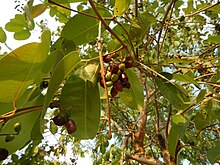피루바테신타아제
Pyruvate synthase| 피루바이트 싱타아제 | |||||||||
|---|---|---|---|---|---|---|---|---|---|
 데설포비브리오 아프리카누스, 피루바테 싱타아제 디머 | |||||||||
| 식별자 | |||||||||
| EC 번호 | 1.2.7.1 | ||||||||
| CAS 번호. | 9082-51-3 | ||||||||
| 데이터베이스 | |||||||||
| 인텐츠 | IntEnz 뷰 | ||||||||
| 브렌다 | 브렌다 입력 | ||||||||
| 엑스퍼시 | 나이스자이메 뷰 | ||||||||
| 케그 | KEG 입력 | ||||||||
| 메타사이크 | 대사통로 | ||||||||
| 프리암 | 프로필 | ||||||||
| PDB 구조 | RCSB PDB PDBe PDBsum | ||||||||
| 진 온톨로지 | 아미고 / 퀵고 | ||||||||
| |||||||||
효소에서는, 피루바이트 싱타아제(EC 1.2.7.1)는 피루바이트와 아세틸-CoA의 상호 변환을 촉진하는 효소다.피루베이트:페레독신 산화효소(PFOR)라고도 한다.
PFOR에 의해 강등되는 관련 평형은 다음과 같다.
- 피루베이트 + CoA + 산화 페레독신 아세틸-CoA + CO2 + 감소 페레독신
이 효소의 기질 3개는 피루베이트, COA, 산화페레독신인데 반해 3개 제품은 아세틸-CoA, CO2, 환원페레독신이다.
함수
이 효소는 화농산염 대사, 프로포노산염 대사, 부탄산염 대사, 환원성 카르복실산 사이클(CO2 고정)의 4가지 대사 경로에 참여한다.
그것의 주요 역할은 디카복시화에 의한 등가물 감소 추출이다.에어로빅 유기체에서 이 변환은 피루베이트 탈수소효소에 의해 촉매화되며 티아민 피로인산염(TPP)을 사용하지만 전자 수용체로서 리포이트에 의존한다.에어로빅 효소 복합체 PFOR와는 달리 환원성분을 플라빈이나 철-설플루르 성단으로 전달한다.이 과정은 글리코분해를 우드-중달 경로와 연결한다.
명명법
이 효소는 산화효소 계열에 속하며, 특히 철황 단백질을 수용체로 하여 기증자의 알데히드나 옥소 그룹에 작용하는 효소들이다.[1]이 효소 등급의 체계적 명칭은 피루베이트:페레독신 2-옥시도렐라제(CoA-acetylating)이다.일반적으로 사용되는 다른 이름에는 다음이 포함된다.
- 화농산 산화효소,
- 피루바이트 합성효소
- 피루베이트:페레독신 산화효소,
- 피루빅-페레독신 산화효소
구조
PFOR은 조광 구조를 채택하는 반면, 각 모노메릭 서브 유닛은 하나 이상의 폴리펩타이드 체인으로 구성된다.[1]PFOR의 각 모노메릭 서브 유닛은 TPP 분자 1개와 [4Fe-4S] 클러스터 3개를 결합하는 6개의 도메인으로 구성된다.[2]
촉매 메커니즘
PFOR 반응은 락틸-TPP 유도체를 형성하는 피루베이트의 2-oxo 탄소에 대한 TPP의 C2의 핵포함 공격에서 시작된다.다음으로, 락틸-TPP 유도체는 음이온 중간을 형성하는 CO2 계수를 방출하고, 그 다음 전자를 [4Fe-4S] 군집으로 전달한다.이러한 단계는 전자파자기공명(EPR) 실험에 의해 관측될 수 있는 안정적인 급진적 중간으로 이어진다.급진적 중간은 CoA 분자와 반응하여, 급진적 중간에서 다른 전자를 [4Fe-4S] 군집으로 전달하고 아세틸-CoA 제품을 형성한다.[3]
억제제
- Nitazoxanide는 Giardiasis와 Cryptosporidiodosis의 치료에 사용되는 광범위 항타라스틱제 및 FDA 승인 PFOR 억제제다.[4][5]
- 티즈옥사니드(Tizoxanide)는 니타조산화물의 활성대사물이다.
- 니타조산화물의 수용성 파생물질인 아믹시틸은 피루베이트:페레독신 산화유도효소의 강력한 억제제로 헬리코박터 파일로리와 클로스트리디움 디피실리의 감염을 치료하기 위한 임상 전 연구 중이다.[6][7]
참조
- ^ a b Gibson MI, Chen PYT, Drennan CL (2016). "A structural phylogeny for understanding 2-oxoacid oxidoreductase function". Current Opinion in Structural Biology. 41: 54–61. doi:10.1016/j.sbi.2016.05.011. PMC 5381805. PMID 27315560.
- ^ Chen PYT, Aman H, Can M, Ragsdale SW, Drennan CL (2018). "Binding site for coenzyme A revealed in the structure of pyruvate:ferredoxin oxidoreductase from Moorella thermoacetica". Proc Natl Acad Sci U S A. 115 (15): 3846–3851. doi:10.1073/pnas.1722329115. PMC 5899475. PMID 29581263.
- ^ Ragsdale SW (2003). "Pyruvate ferredoxin oxidoreductase and its radical intermediate". Chemical Reviews. 103 (6): 2333–2346. doi:10.1021/cr020423e. PMID 12797832.
- ^ Di Santo N, Ehrisman J (2013). "Research perspective: potential role of nitazoxanide in ovarian cancer treatment. Old drug, new purpose?". Cancers (Basel). 5 (3): 1163–1176. doi:10.3390/cancers5031163. PMC 3795384. PMID 24202339.
Nitazoxanide [NTZ: 2-acetyloxy-N-(5-nitro-2-thiazolyl)benzamide] is a thiazolide antiparasitic agent with excellent activity against a wide variety of protozoa and helminths. ... Nitazoxanide (NTZ) is a main compound of a class of broad-spectrum anti-parasitic compounds named thiazolides. It is composed of a nitrothiazole-ring and a salicylic acid moiety which are linked together by an amide bond ... NTZ is generally well tolerated, and no significant adverse events have been noted in human trials [13]. ... In vitro, NTZ and tizoxanide function against a wide range of organisms, including the protozoal species Blastocystis hominis, C. parvum, Entamoeba histolytica, G. lamblia and Trichomonas vaginalis [13]
- ^ "Nitazoxanide Prescribing Information" (PDF). United States Food and Drug Administration. Romark Pharmaceuticals. 3 March 2004. pp. 1–9. Retrieved 3 January 2016.
- ^ Warren CA, van Opstal E, Ballard TE, Kennedy A, Wang X, Riggins M, Olekhnovich I, Warthan M, Kolling GL, Guerrant RL, Macdonald TL, Hoffman PS (August 2012). "Amixicile, a novel inhibitor of pyruvate: ferredoxin oxidoreductase, shows efficacy against Clostridium difficile in a mouse infection model". Antimicrob. Agents Chemother. 56 (8): 4103–11. doi:10.1128/AAC.00360-12. PMC 3421617. PMID 22585229.
- ^ Hoffman PS, Bruce AM, Olekhnovich I, Warren CA, Burgess SL, Hontecillas R, Viladomiu M, Bassaganya-Riera J, Guerrant RL, Macdonald TL (2014). "Preclinical studies of amixicile, a systemic therapeutic developed for treatment of Clostridium difficile infections that also shows efficacy against Helicobacter pylori". Antimicrob. Agents Chemother. 58 (8): 4703–12. doi:10.1128/AAC.03112-14. PMC 4136022. PMID 24890599.
추가 읽기
- Evans MC, Buchanan BB (1965). "Photoreduction of ferredoxin and its use in carbon dioxide fixation by a subcellular system from a photosynthetic bacterium". Proc. Natl. Acad. Sci. U.S.A. 53 (6): 1420–5. Bibcode:1965PNAS...53.1420E. doi:10.1073/pnas.53.6.1420. PMC 219872. PMID 5217644.
- Gehring U, Arnon DI (1972). "Purification and properties of -ketoglutarate synthase from a photosynthetic bacterium". J. Biol. Chem. 247 (21): 6963–9. doi:10.1016/S0021-9258(19)44680-2. PMID 4628267.
- Uyeda K, Rabinowitz JC (1971). "Pyruvate-ferredoxin oxidoreductase. 3. Purification and properties of the enzyme". J. Biol. Chem. 246 (10): 3111–9. doi:10.1016/S0021-9258(18)62202-1. PMID 5574389.
- Uyeda K, Rabinowitz JC (1971). "Pyruvate-ferredoxin oxidoreductase. IV. Studies on the reaction mechanism". J. Biol. Chem. 246 (10): 3120–5. doi:10.1016/S0021-9258(18)62203-3. PMID 4324891.
- Charon MH, Volbeda A, Chabriere E, Pieulle L, Fontecilla-Camps JC (1999). "Structure and electron transfer mechanism of pyruvate:ferredoxin oxidoreductase". Curr. Opin. Struct. Biol. 9 (6): 663–9. doi:10.1016/S0959-440X(99)00027-5. PMID 10607667.



